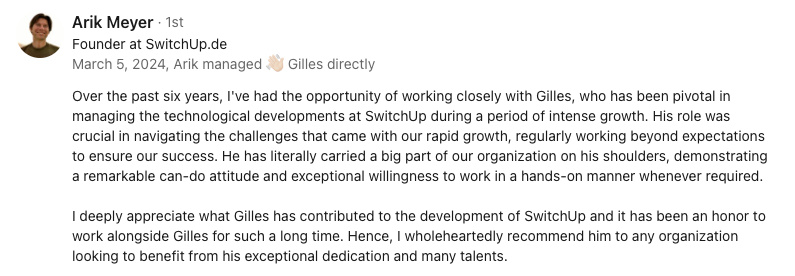Abstract:
The article discusses Swift, a programming language that has gained popularity for its seamless integration with Apple's machine learning frameworks, Core ML and Create ML. This integration allows developers to easily incorporate machine learning into apps, enhancing functionality and user experiences. Core ML supports on-device model deployment with type safety, reducing errors and boosting reliability, while Create ML simplifies model training, making it accessible even for those new to machine learning. Swift's efficient runtime and compatibility with Apple's hardware facilitate fast processing and real-time applications, such as games and augmented reality, while maintaining user data privacy. Startups benefit from using Swift and machine learning to enhance app functionality and differentiate in the market, with personalized user experiences and predictive analytics providing competitive advantages. Real-world applications include image recognition and natural language processing, as seen in apps like Snapchat and financial tools offering personalized insights. Success stories from companies like Revolut and Babbel highlight the potential of combining Swift and machine learning for innovative app solutions. Best practices in integrating Swift with machine learning include optimizing performance and scalability, emphasizing techniques such as model optimization and asynchronous processing. Looking ahead, Swift is poised to play a significant role in future AI developments, supporting trends in on-device AI processing and augmented reality, and offering a robust toolkit for developers to push the boundaries of mobile app innovation.
In the world of app development, keeping up with new technology can be challenging. As programming languages and frameworks evolve, developers face the task of incorporating new features into their apps. Swift, a programming language, has gained popularity due to its safety, speed, and expressiveness, which are crucial for developing robust applications. It also integrates well with machine learning tools like Core ML and Create ML, simplifying the machine learning process for developers. Whether you're experienced or new to coding, using Swift can transform how you build apps, enhancing functionality and user experiences.
Swift's seamless integration with machine learning frameworks
Swift is rapidly growing in the tech industry, partly because it works so effectively with Apple's Core ML and Create ML. This compatibility allows developers to easily incorporate machine learning into their apps, leveraging Swift's robust features.
Core ML and Create ML integration
Core ML enables developers to integrate machine learning models into their apps effortlessly. With Swift, they can utilize type safety to minimize errors, enhancing the reliability of their work. This integration instills confidence in developers and reduces the likelihood of bugs.
Create ML simplifies the process of training models, especially for those new to machine learning. As part of Xcode, it uses Swift to offer an easy method for data preparation and model training. This accessibility allows developers to focus on improving user experiences without delving deeply into machine learning intricacies.
Once models are ready with Create ML, they can be seamlessly deployed within Apple's ecosystem. This streamlined process makes Swift a preferred choice among developers creating dynamic, machine-learning apps.
Advantages of Swift for machine learning
Swift's efficient runtime with Core ML enables quick on-device processing, boosting app speed and maintaining user data privacy by avoiding network transmission. Swift also pairs well with Apple's hardware to support real-time applications, such as games or augmented reality, providing developers with the tools to create interactive, engaging experiences.
Using Swift, developers tap into a powerful ecosystem for high-performance apps. It's a strategic choice for startups aiming to leverage machine learning to create standout mobile solutions.
Leveraging Swift for Startup Success
Swift and machine learning open up new possibilities for startups, helping them enhance apps and differentiate themselves in the market. AI can drive innovation and capture a larger market share.
Enhancing app functionality
Machine learning allows apps to deliver personalized experiences, increasing user engagement. By analyzing data, AI customizes content and interactions to user preferences, boosting satisfaction and retention.
AI also enhances operations through predictive analytics, enabling startups to anticipate needs and optimize resources. This competitive advantage allows them to adapt swiftly to market changes.
Market differentiation
AI enables startups to set their products apart with unique experiences and features. This goes beyond simply adding features to delivering real value to users. Offering something competitors don't can attract and retain users, expanding market presence.
Innovative AI solutions foster customer loyalty by providing consistent, high-quality experiences. This focus on innovation is crucial for startups competing in crowded markets.
Practical applications and use cases
Real-world examples demonstrate how Swift and Apple's machine learning tools enhance app capabilities in areas like image recognition and predictive analytics.
Real-world machine learning applications
- Image recognition apps using Swift and Core ML offer real-time object detection, enhancing user interaction. Apps like Snapchat utilize this technology for dynamic augmented reality filters.
- Swift supports natural language processing, enabling voice recognition and text translation, making user interaction more natural and intuitive.
- In finance, predictive analytics in Swift apps provide personalized insights, improving user engagement. These insights help users better manage their finances, building trust and making the app an essential tool.
Success stories
Startups like Revolut and Babbel illustrate how machine learning enhances app functionality and market presence. Revolut employs ML for real-time fraud detection, bolstering security. Babbel uses ML to personalize language learning, making it more engaging. These examples highlight the benefits of combining Swift and machine learning for distinctive user experiences.
Best practices for integrating Swift and machine learning
Understanding best practices for integrating Swift with machine learning frameworks ensures effective performance and scalability.
Optimizing performance
Optimizing machine learning models in Swift apps is essential for smooth user experiences. Techniques like model optimization and quantization enhance speed, crucial for mobile deployment. Asynchronous processing maintains UI responsiveness by offloading tasks from the main thread.
Scalability strategies
Balancing scalability with speed in the Swift ecosystem can be achieved through batch processing and data augmentation, allowing models to adapt to varying conditions. Server-side processing can handle heavy computations, ensuring consistent app performance.
Future Trends and Opportunities
Trends in mobile AI development
On-device AI processing and augmented reality are transforming apps by enabling real-time analytics and interactive experiences. Swift supports these features through its frameworks, helping apps provide quick responses.
Natural language processing and real-time analytics are becoming essential, with Swift facilitating their development. Swift's role in future innovations is likely to grow, pushing the limits of mobile AI.
Swift's position in future innovations
Swift's evolving tools help developers add AI features to keep projects competitive. Its focus on performance optimization ensures efficient app operation. Swift's expressiveness aids in rapid development, allowing developers to quickly iterate and innovate. As Swift evolves, staying updated with its capabilities is crucial for leveraging its potential.
Swift, with Core ML and Create ML, offers a powerful toolkit for developers. It simplifies machine learning integration, enhancing app capabilities and opening new opportunities for differentiation. From real-time image recognition to predictive analytics, the possibilities are endless. Swift isn't just a language; it's a gateway to innovation in app development.
You might be interested by these articles:
- Swift's Leap: Mastering Concurrency and Performance
- SwiftUI For Cross-Platform Development
- Advancing with Swift: Efficiency and Elegance





